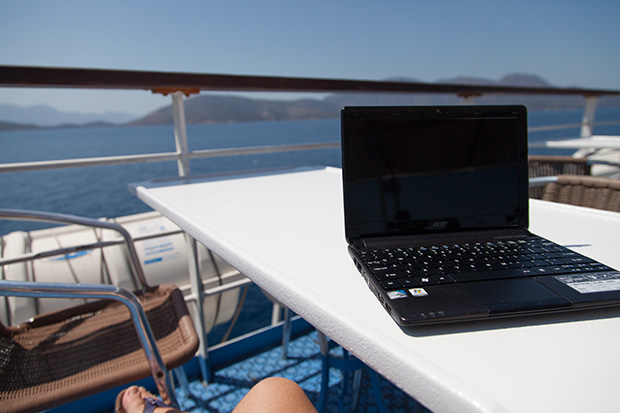
Royal Caribbean Cruises is ramping up wireless access onboard its cruise ships as passengers demand increased ability to connect while out at sea.
Royal Caribbean CIO Bill Martin is upgrading wireless access on the company’s 42 cruise ships, allowing passengers to have access from “bow-to-stern”, with enough bandwidth to allow connectivity for “basic things like email and Facebook ,” but not streaming videos. “It’s a connection but not a very fast connection.”
But even a sluggish connection onboard cruise ships, miles out to sea, means overcoming technical challenges. The upgrade follows years of customer complaints that internet access was too limited onboard the vessels, Martin said. “To be in consideration as a way people spend their discretionary dollars, our guests have the expectation that they will be able to get connected.”
Royal Caribbean’s upgrade proceeded as it posted a $3.7 million loss in the second quarter, on the calamitous European economy and the deadly January crash of rival Carnival’s Costa Concordia. At the same time the company lowered its earnings estimate for the entire year.
As the number of tablets and smartphones continue to increase, CIOs at consumer-oriented companies are under greater pressure to provide wireless access across shopping centers, hotels and even outdoor arenas.
But the nature of ocean voyages and the solid steel structure of cruise vessels make the task enabling wireless access at sea particularly daunting. “We can’t just use some very long fiber cable,” Martin said.
Instead the cruise passengers rely on satellite dishes mounted onboard the vessels. Most of the ships currently use a satellite that provides entire vessels approximately the bandwidth available in a typical home, said Max Schmidt, vice president for IT operations at Royal Caribbean.
“It’s painfully slow,” Martin said.
The company is upgrading to more powerful satellites, delivering a seven-fold increase in bandwidth, in the first quarter of 2013.
The other technical hurdle is the solid steel body of the ships themselves. Wireless signals from different channels bounce off the surface and into one another, causing interference and spotty service. The issue of interference from multiple channels had forced Royal Caribbean to limit wireless access on the ships to several hotspots.
In order to create “pervasive” wireless across an entire ship, Martin is wiring vessels with a network that utilizes a single channel, to avoid interference issues.
So far Martin has upgraded about 14 ships of the company’s fleet. Though the connection speeds are not as fast as a typical consumer connection, Martin says guests are already giving positive feedback.
“We are shocking guests. Not only can they get a connection – not a very fast connection – but they can access it anywhere on the ship and they see this as a very significant step forward,” Martin said.
By Joel Schectman, Wall Street Journal












Recommended Comments
Join the conversation
You can post now and register later. If you have an account, sign in now to post with your account.